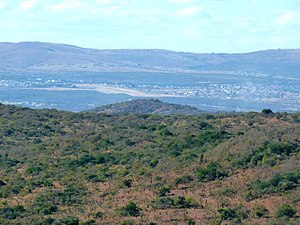Battle of Gqokli Hill
| Battle of Gqokli Hill | |||||||
|---|---|---|---|---|---|---|---|
| Part of Zulu Civil War | |||||||
 Gqokli hill seen from eMakhosini, with Ulundi in the background |
|||||||
|
|||||||
| Belligerents | |||||||
| Zulu and allies | Ndwandwe | ||||||
| Commanders and leaders | |||||||
| Shaka | Nomahlanjana | ||||||
| Strength | |||||||
| 5,000 (est w allies) | 12,000 (est) | ||||||
| Casualties and losses | |||||||
| 2,000 killed and wounded | 7,500 killed and wounded | ||||||
The Battle of Gqokli Hill was conducted in about April 1818, a part of the Mfecane, between Shaka of the Zulu nation and Zwide of the Ndwandwe, in Shaka's territory just south of present-day Ulundi ( 28° 22' 23" S 31° 21' 15.77" E).
This was to be Shaka's first major battle against the dominant power in southeastern Africa (what would eventually become kwaZulu Natal), the Ndwandwe Paramountcy, led by nKosi (king) Zwide. The Ndwandwe king, who had assassinated the nKosi of the Mthethwa Paramountcy, Dingiswayo, the year before, was actively trying to absorb or exterminate the surviving members of that kingdom, including the then-small Zulu clan under their new chief, Shaka.
In spite of being significantly outnumbered, masterful strategy and tactics won the battle for Shaka. To delay the Ndwandwe invasion army, under command of Zwide's eldest son and heir, Nomahlanjana, Shaka posted forces along the drifts (fords) of the White Umfolozi River to delay the enemy while the river was still relatively high. Meanwhile, he laid waste to the area on the south (Zulu) side the river,and moved most of his clan's noncombatants and cattle into hiding in the Nkandla Forest, on the southern extremities of Zulu land. He then placed the bulk of his troops around the top of Gqokli hill, with a reserve and all his supplies out of sight in a depression at the top of the hill. To Nomahlanja, it seemed like a much smaller force of Zulus at the top of the hill and he anticipated it would be an easy massacre, "Like butchering cattle in a kraal," his is reputed to have said.
Before the Ndwandwe army was across the river and surrounding his hilltop position, Shaka dispatched about 700 from his small army, with a fraction of the clan's cattle herd, to make a display about ten kilometers south of Gqokli and tempt Nomahlanjana to split his force to capture them. The Ndwandwe general, thinking he was seeing the entire Zulu herd and half their army, obliged by sending four regiments (about 4,000 men) off to chase the cattle down.
By about nine o'clock in the morning, once all eight of the remaining Ndwandwe regiments (about 8,000) were arrayed at the bottom of Gqokli Hill, Nomahlanjana gave the signal for the attack. In the first charge up the slopes, it quickly became apparent that the Ndwandwe superiority in numbers would actually be a hindrance, for the converging formations began to crowd into each other, making it difficult to throw their spears effectively. And when Shaka ordered a counter-attack, his men, who had no throwing spears (assegai) but were armed with the new, shorter, stabbing assegai(amaKlwa), charged downhill and routed the packed mob of Ndwandwes.
...
Wikipedia
